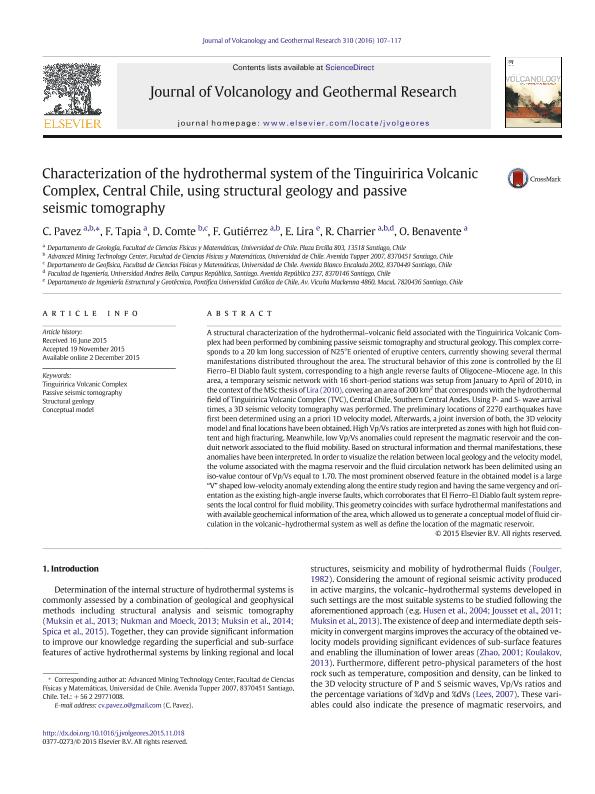Artículo
Characterization of the hydrothermal system of the Tinguiririca Volcanic Complex, Central Chile, using structural geology and passive seismic tomography
Pavez, C.; Tapia Silva, Felipe Fernando ; Comte, D.; Gutierrez, Francisco; Lira, E.; Charrier González, Reynaldo; Benavente, O.
; Comte, D.; Gutierrez, Francisco; Lira, E.; Charrier González, Reynaldo; Benavente, O.
 ; Comte, D.; Gutierrez, Francisco; Lira, E.; Charrier González, Reynaldo; Benavente, O.
; Comte, D.; Gutierrez, Francisco; Lira, E.; Charrier González, Reynaldo; Benavente, O.
Fecha de publicación:
12/2015
Editorial:
Elsevier Science
Revista:
Journal of Volcanology and Geothermal Research
ISSN:
0377-0273
Idioma:
Inglés
Tipo de recurso:
Artículo publicado
Clasificación temática:
Resumen
A structural characterization of the hydrothermal–volcanic field associated with the Tinguiririca Volcanic Complex had been performed by combining passive seismic tomography and structural geology. This complex corresponds to a 20 km long succession of N25°E oriented of eruptive centers, currently showing several thermal manifestations distributed throughout the area. The structural behavior of this zone is controlled by the El Fierro–El Diablo fault system, corresponding to a high angle reverse faults of Oligocene–Miocene age. In this area, a temporary seismic network with 16 short-period stations was setup from January to April of 2010, in the context of the MSc thesis of Lira (2010), covering an area of 200 km2 that corresponds with the hydrothermal field of Tinguiririca Volcanic Complex (TVC), Central Chile, Southern Central Andes. Using P- and S- wave arrival times, a 3D seismic velocity tomography was performed. The preliminary locations of 2270 earthquakes have first been determined using an a priori 1D velocity model. Afterwards, a joint inversion of both, the 3D velocity model and final locations have been obtained. High Vp/Vs ratios are interpreted as zones with high hot fluid content and high fracturing. Meanwhile, low Vp/Vs anomalies could represent the magmatic reservoir and the conduit network associated to the fluid mobility. Based on structural information and thermal manifestations, these anomalies have been interpreted. In order to visualize the relation between local geology and the velocity model, the volume associated with the magma reservoir and the fluid circulation network has been delimited using an iso-value contour of Vp/Vs equal to 1.70. The most prominent observed feature in the obtained model is a large “V” shaped low-velocity anomaly extending along the entire study region and having the same vergency and orientation as the existing high-angle inverse faults, which corroborates that El Fierro–El Diablo fault system represents the local control for fluid mobility. This geometry coincides with surface hydrothermal manifestations and with available geochemical information of the area, which allowed us to generate a conceptual model of fluid circulation in the volcanic–hydrothermal system as well as define the location of the magmatic reservoir.
Archivos asociados
Licencia
Identificadores
Colecciones
Articulos(IDEAN)
Articulos de INSTITUTO DE ESTUDIOS ANDINOS "DON PABLO GROEBER"
Articulos de INSTITUTO DE ESTUDIOS ANDINOS "DON PABLO GROEBER"
Citación
Pavez, C.; Tapia Silva, Felipe Fernando; Comte, D.; Gutierrez, Francisco; Lira, E.; et al.; Characterization of the hydrothermal system of the Tinguiririca Volcanic Complex, Central Chile, using structural geology and passive seismic tomography; Elsevier Science; Journal of Volcanology and Geothermal Research; 310; 12-2015; 107-117
Compartir
Altmétricas



